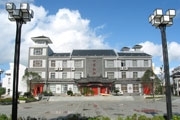The ShilihongzhuangWeddingCustomsMuseum, a private one, sits in Xu Xiake Avenue of Ninghai. Within the Museum are exhibited over 1000 pieces of work, either furniture, articles or utensils, which were mainly for Shilihongzhuang use, namely, for wedding or dowry use. It is appraised as a Class-5 tourist resource of the country.
Upon entering the Museum, one will immediately be appealed to the galaxy works of artistic flavor; he or she would find him/herself part of folk customs back in the Ming and Qing Dynasties. There are big item, like beds and furniture, or small items like needles and thread. The collections include jewelry, garments and cloth, candlesticks and lamps, beds, cabinets, tables, pillow, quilts, mosquito nets, gauze kerchiefs, shoes and socks, bronze basins and other bronze ware, porcelain ware, spoons, plates, washing and combing articles, fancy things, stationery, etc, everything that a bride needed when she left for the bridegroom and started a new family life.
The so-called Shilihongzhuang refers to the scene of a Chinese family marrying the daughter. In ancient days, people often used “abundant fertile land plus shilihongzhuang dowry” to depict a generous dowry. Tradition had it that on the day before the wedding day, large items like beds,mirrored dressing case, thread plates and spindles were delivered to the bridegroom’s, while other items like bedding stuff, clothes, shoes, jewelry, quilts and other woman-use valuables would go with the sedan chair with the bride on the very day of wedding ceremony. The bridesmaid would spread out the dowry on the wedding bed to showcase the dowry, which was called Bed-making.
When the dowry parade was on the way to the bridegroom’s, the big furniture item would be carried by two men, the red washing barrels, pots , trunks and other wooden utensils would be carried by two persons in a large red box. These dowry articles, mostly of red lacquer, were lustrous, shining and magnificent. The parade of the dowry team would line up kilometers long, moving from the Bride’s home to the Bridegroom’s. The whole proceeding was auspicious, mainly to show off the extravagance and wealth of the family.
The dowry furniture would consist of in-chamber items and outer-chamber items. The former included the Qiangong bed (made with a thousand days’ work of a carpenter), table, closets and cupboards of red lacquer, stools, clothes stands, night stools, barrels, dressing table, etc. The latter included the painting table, table for musical instrument, square table, and round-backed armchair. These furniture items could fall into three categories: daily use, small wooden items of lacquer, and needlework and other woman-use stuff.
The furniture and lacquered articles are passed down from the Qing Dynasty and the Minguo period. They are all art works of carving, engraving, painting, gilding, coating with golden paint and cover painting, which are simple, elegant and splendid. Among them, the so-called China Red cinnabar lacquer can be the gems of Chinese art and also the manifestation of the traditional lacquering and carving techniques of Ningbo and Shaoxing. The techniques are applied to the dressing tables, wine jugs, arm-chairs, trunks etc. Some are carved in some parts, some are carved overall, looking either simple and graceful, or magnificent. Some of them are shaped elegant or ambient with life, with strong cultural flavor. The red-lacquered small barrels in particular are round and smooth, looking elegant with simplicity, round and smooth.
If the robust and graceful red chests of drawers are compared to the local men, the light and smooth barrels can be seen as the slender and beautiful girls of the Ningbo and Shaoxing areas. The collections in the Museum can not only give off beauty, but takes on rich cultural flavor. Meanwhile they serve as material objects for the social and cultural studies related to the East Zhejiang in the Ming and the Qing Dynasties.
The scene of Shilihongzhuang is bygones now as the women’s social status has been much improved. Yet it is our responsibility to learn about and probe into their life and living space, because they were our ancestors.
The owner of the private Museum Mr. He Xiao Dao is an artist with a keen eye for folk art. During a period of two decades, he has been collecting rare works while running Ming and Qing –style furniture business. These are the remains of traditional Chinese culture. With the rapid changes of the society, the folk customs and antiquities of China are melting away. The private museum of Shilihongzhuang is He Xiaodao’s maneuver of keeping the traditional customs typical in east Zhejiang. His deeds should be applauded.
 Key Point Of Interest
Key Point Of Interest
|
Shilihongzhuang Wedding Customs Museum |
